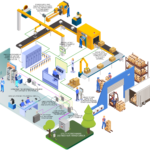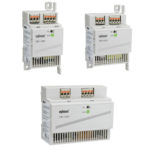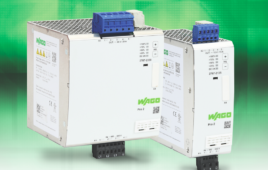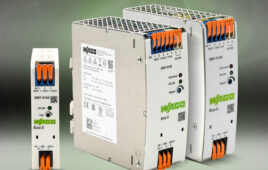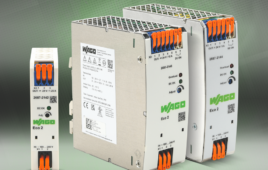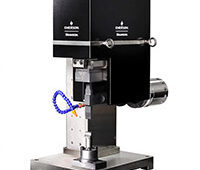A top challenge in industrial electronics is the integration of sensing and feedback — in part because their disparate outputs require clean and safe transmission to the installation’s PLC or other primary controller. For these connections, system integrators rely on signal conditioners and isolation amplifiers. While both devices serve as an intermediary point in power and data transmission, they are different in design, functionality, and purposes.
Signal conditioners are devices having a signal processor or microprocessor that converts signals from one form to another. In industrial applications, signal conditioners convert otherwise unsupported sensor output into a readable signal for the primary controller. For example, a type-N thermocouple generates nonlinear output unsuitable for PLCs only accepting linear input. In the same way, a load cell’s unamplified output at 30 mV directly fed into a PLC or other control’s 0-to-10-V analog input will yield inaccurate tracking — as the sensor’s range maps to just a fraction of the controls’ analog-to-digital converter (ADC) resolution.

Signal conditioners are often used in data-acquisition applications.
But with signal conditioners these issues are avoided. That’s because signal conditioners sample sensor signals upon their reception, perform various signal-processing tasks, and convert the input to signals or protocols commonly accepted by PLCs. More specifically, signal conditioners can typically support the following output:
• 0 to 20 mA and 4 to 20 mA
• 0 to 10 V
• PROFIBUS TCP
• CAN bus
• Modbus TCP/IP and RS485
Signal conditioners are usually built to pair with (and accept input from) specific sensor types. So for example, a signal conditioner for thermocouples will typically accept 0 to 10-mV input. In addition, beyond simply converting signals, signal conditioners have the electronics to also execute tasks related to:
Amplification — Signal conditioners can amplify sensor values to a magnitude that satisfies the analog input requirements of the systems PLC.
Filtering certifications, approvals, and class ratings — Analog sensor signals (especially those in the millivolt range) are susceptible to electrical noise. Signal conditioners filter such noise with internal signal-processing algorithms and passive filters.
Linearization — Nonlinear sensor output is mapped to a linear scale.
Smart monitoring and control — Some signal conditioners have relay outputs that activate when a measured value exceeds some preset value. That in turn makes for locally executed control performed independently from the primary system controller.
Protection — Signal-conditioner inputs are physically isolated from the output to prevent surge and other transient events from damaging any attached power or control electronics.
There are even signal conditioners on the market today that (beyond serving as current and voltage signal conditioners that record dc and ac) work as power-signal conditioners that measure power-supply current and voltage in parallel — and then convert them to standard analog-signal output.
Contrasting conditioners with isolation amplifiers

This is a simplified block diagram of an isolation amplifier.
Another piece of electronics to ensure clean signal transmission and reception is the isolation amplifier. Isolation amplifiers are advanced electronics having two stages of operational-amplifier or op-amp circuits separated by an isolation barrier. Their purpose is to electrically separate circuits associated with incoming and outgoing power. They’re commonly available in through-hole or surface-mounted formats.
Despite what their name may imply, isolation amplifiers don’t necessarily amplify signals into a system. Instead, they’re configurable with divider resistors that set a gain factor. Where amplification is unneeded, isolation amplifiers work as unity-gain op-amps. Isolation amplifiers in turn derive these characteristics from their operational amplifiers — for high input impedance and low output impedance. In addition, isolation amplifiers include the isolation barrier mentioned earlier to separate signal paths.
This isolation barrier is based on one of the three technologies.
Transformer isolation — Isolation amplifiers with these transformers use them to separate the input and output circuits by modulating input signals with a high-frequency carrier — then transferring them from primary to secondary coils. The modulated signal is then demodulated, and its original signal goes onward to the output.
Optical isolation — Isolation-amplifier optoisolator barriers convert input signals into (electrically isolating) light … and then recreate those signals as electric signals at an output-side photosensitive receiver.
Capacitive isolation — Isolation amplifiers with capacitive isolation use a capacitive barrier to separate input and output. Transmission is through the charging and discharging of the capacitor terminals with modulated signals.
Of the above technologies, transformers and capacitive-isolation amplifiers rely on a modulator and demodulator — involving an input value coupled to the output via a high-frequency carrier. This is because dc signals can’t pass through the systems’ transformer or capacitor. By keeping both input and output electrically isolated, the isolation amplifier effectively protects sensors and controllers from surges, transient events, and high common-mode voltage.

Some signal conditioners are designed to connect to Rogowski coils — electric coil-shaped transducers that wrap around a cable carrying ac power to sniff out high-speed transients, power-device pulsed currents, or 50 or 60-Hz utility-mains currents. In fact, even very compact Rogowski coils can measure currents to thousands of amperes.
Where signal conditioners and isolation amplifiers are necessary
Signal conditioners often complement sensors to produce signals matching the controller’s input specifications. They also unburden main controllers by executing complex algorithms such as noise filtering and linearization. Engineers can even use signal conditioners as safety buffers to prevent controllers from malfunctioning should attached sensors sustain damage from short circuits or surges.
Isolation amplifiers excel in applications needing one or both sides of the circuits to be protected from transient or high common-mode voltage. They’re especially common medical devices that must protect patients from electrical injury. Isolation amplifiers are also common in industrial-automation applications involving very high common-mode voltage differences between controllers and attached sensors.
You may also like:
Filed Under: Power supplies



